Are you looking for the best way to teach prefixes? This mini teaching guide shows you how! And don’t miss the free printable prefix list, along with activities that help your child master words with prefixes.
What Is a Prefix?
A prefix is a word part that is placed in front of a base word. Common prefixes include pre, bi, and anti. Take a look at the examples below.

A prefix usually changes the meaning of the base word.
Think about the word happy. The prefix un placed in front of the word happy makes a new word with a new meaning: unhappy. The prefix un means not so it changes the meaning of the word happy to not happy.

The Two Most Common Prefixes
The most common prefixes are un and re. These two prefixes are the most useful for beginning spellers to learn because they appear frequently and their meanings are easy to understand and remember.

Un means not (unhappy = not happy) or the reverse of, or opposite of (as in untie).

Re means again (redo = do again) or back (as in repay).
If you’re interested in learning more about prefixes, download and print this list of 90 common prefixes.
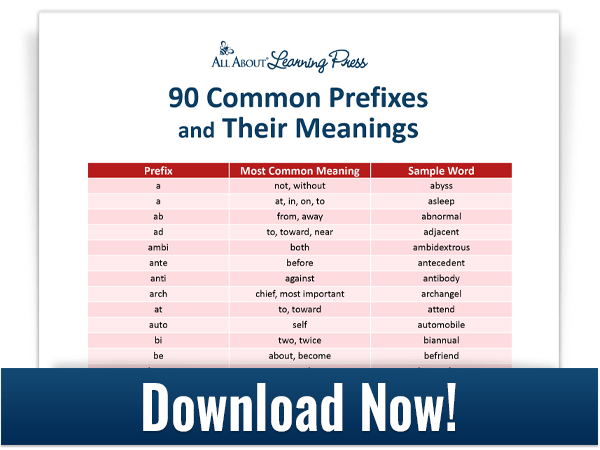
Tips for Adding Prefixes
Tip 1: The spelling of the base word never changes. Simply add the prefix to the beginning of the base word, as in the word tricycle.

Tip 2: Be aware that double letters can occur. If you add the prefix un to natural, both the prefix and the base word retain their original spelling. The result is unnatural.

Other examples where double letters occur include misspell, irregular, and unnoticeable.
Tip 3: Watch out for prefix look-alikes. Some words contain the same string of letters as a prefix, but upon closer examination you’ll find that they are not prefixes. The re in real is not a prefix.

Other examples include uncle, pretty, and interest.
Tip 4: Sometimes a hyphen is needed. If you are working with an older student, it is handy to know the six rules for adding prefixes found in the next section.
6 Rules for Using Hyphens with Prefixes
A prefix is usually added directly to the base word, but there are several cases where a hyphen is needed.
Rule 1: Hyphenate the word when you add a prefix to a proper noun or a numeral.

Rule 2: Hyphenate the word when you add the prefix ex meaning former.

(Do not use a hyphen if ex means out of or away from, as in expel.)
Rule 3: Hyphenate after the prefix self.

Rule 4: Hyphenate to separate two A’s, two I’s, or other letter combinations that might cause misreading or mispronunciation.

Rule 5: A hyphen may be used to separate two E’s or two O’s to improve readability or prevent mispronunciation.

Note that many words with double E’s used to be hyphenated as a general rule, as in re-elect, re-establish, and pre-existing. However, current style manuals and dictionaries now tend toward “closing” the word except in cases where readability is affected. Both versions are currently accepted and listed in most dictionaries.
Rule 6: A hyphen is sometimes used after the prefix re to prevent misreading or confusion with another word.

As in “Re-cover the boat when you recover from the flu.”

As in “Please relay the message that they will re-lay the tiles.”
Printable Activities for Learning Prefixes
By now you’ve probably realized that we take prefixes very seriously here at All About Reading and All About Spelling! And though this guide to prefixes may seem like a lot of information, we don’t overload your child with all of this material at once. We teach just one small concept at a time, incrementally.
Here are a few prefix activities from All About Reading and All About Spelling.
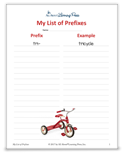
My List of Prefixes
Download our blank list and let your kids create their own list of prefixes. Start with a few examples and have them add to the list as they discover more words with prefixes. Discuss the meanings of the words on the list as they are added.
We hope you feel better equipped with teaching prefixes. Was this post helpful to you? Be sure to check out our mini teaching guide on suffixes, too!




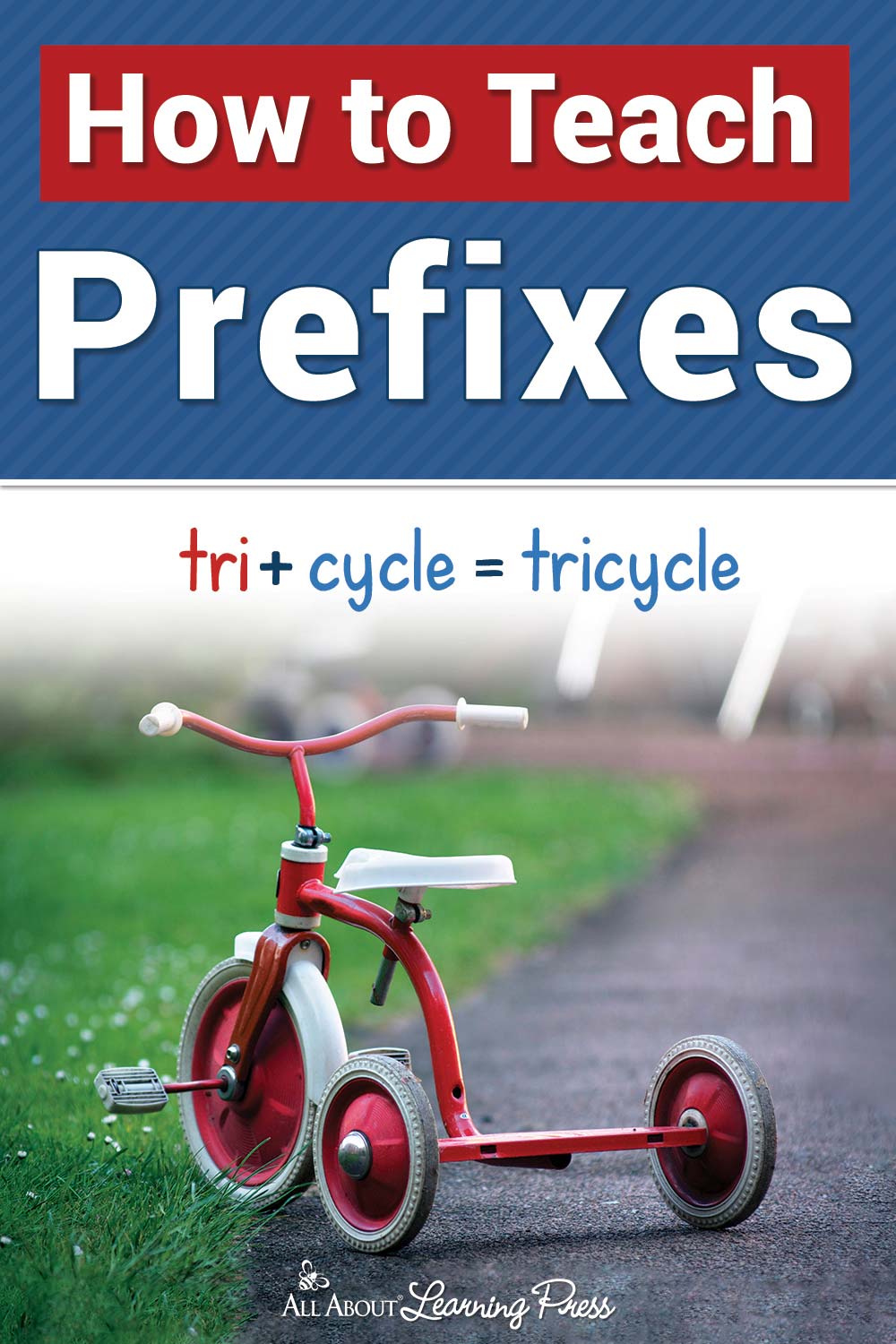















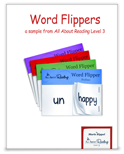
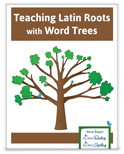

Carol Fridson
says:Great Resource!
Robin
says: Customer ServiceThanks, Carol!
Ali
says:Great information and resources
Robin
says: Customer ServiceThank you, Ali! I’m glad it’s helpful for you.
Vanessa C
says:This is a great website with excellent resources – thanks!
Robin
says: Customer ServiceYou’re welcome, Vanessa! I’m glad the resources are helpful for you!
Sisa
says:thank you so much…the article really helped me a lot
Robin E.
says: Customer ServiceI’m glad this was so helpful for you, Sisa! You’re welcome.
Holly Potter
says:I’m kind of shocked that a program like this has such terrible article for parents. Many examples on the page are incorrect. Disconnect should be dis + con + nect –> disconnect. is the base not connect. Unhappy is un + hap(p) + y. is the base, not happy. Interest DOES have a prefix: inter + esse (perhaps changed from the past participle of interess’d, like kept or slept). It doesn’t even cover chameleon prefixes. You don’t even encourage linking meaning to other derivatives, just prefixes in isolation. I’m very disappointed with this information from a program that is supposed to be OG aligned. It’s perpetuated information like this that keeps parents thinking that English is impossible to spell.
Robin E.
says: Customer ServiceHolly,
Thanks for your feedback. This article is a brief overview of prefixes and how to teach children to read and spell words with them. The article is not meant to be an exhaustive examination of prefixes.
Students in our programs have previously learned how to read and spell words like connect and happy before being introduced to words like disconnect and unhappy. At that point, students are learning how to add prefixes to words they are already familiar with. We refer to “base words” rather than roots or words-parts for this reason. The All About Spelling program does go into more depth with word roots in Level 7. See item #4 in this article on Spelling Strategies.
e
says:Your mini-lessons are so clear and helpful. Thank you!
Robin E.
says: Customer ServiceYou’re welcome!
Amponsah Gideon
says:I am talking about physics
Lulu
says:tutoring adults
Aya
says:Thanks a lot, it was informative and helpful, but how can I cite this article if I want to take some information
Robin E.
says: Customer ServiceI’m glad this was helpful for you, Aya.
However, how to cite this article depends on what format you have been asked to use by your editor, teacher, or whomever you are writing for. I’m sorry I’m not more help, but without knowing what you need there isn’t much I can offer.
Irene
says:This is very helpful indeed. Thanks.
Robin E.
says: Customer ServiceI’m glad this was helpful, Irene. You’re welcome.
Tana
says:Thank you very much.
Robin E.
says: Customer ServiceYou’re welcome, Tana.
Paula
says:I like the independent practice this gives to students.
MUKESH AMBANI
says:its really good
Robin E.
says: Customer ServiceThank you, Mukesh!
hassan semhi
says:Good presentation of the prefixes issue, but the problem is that the post doesn’t explain how we ought to teach prefixes which is really of a paramount importance. Affixes in genreal are taught at colleges. it’s part of the morophological analysis of words. There are no specific rules for their meaning and combination to be taught, but teachers can just incite students of different levels to learn the difference between a root, a stem and morphemes (sometimes are affixes in some languages but in others) and practice a lot of word formation
the list of affixes in english could amounts to 130 affixes
Robin E.
says: Customer ServiceThank you, Hassan.
Yes, affixes are more complex than this blog post covers. However, children are not typically ready to understand the complexities but they still need to know how to read and spell words with prefixes and suffixes. This post attempts to help teach children how to use prefixes in reading and spelling.
Sharyn Miller
says:A fantastic, useable resource for teachers.
Robin E.
says: Customer ServiceThank you, Sharyn!
Elena mulan
says:How do you know if a word us a prefix? I.e how do you identify a prefix
Robin E.
says: Customer ServiceGood question, Elena. One way is to be familiar with prefixes, especially the common ones. This downloaded list on this blog post can help with that. So, when a student sees a word like “unpopular”, he can recognize the prefix “un-” and know the word has a prefix.
The other way is to look for the base word. Take the word “imprison”, for example. Most would notice the base word “prison” in it. It is easy then to tell that “im” is a prefix.
I hope this helps.
Stacey Pugh
says:Thank you so much! This is organized very well and I love your program!!
Robin E.
says: Customer ServiceThank you, Stacey!
sena
says:Hi! I’m a linguistics student at university. This is really helpful. But prefixes could be confusing sometimes. I’m not sure if prefixes like -im, -un come before adverbs. I mean, which way would be more correct while doing immediate constituent analysis for the word “impolitely”, for example, impolite-ly or im-politely? I’d really appreciate if you answer. Thank you!
Robin E.
says: Customer ServiceSena,
I think the issue is far more complex than you are suggesting here.
For the prefixes un- and im-, the part of speech of the base word isn’t really changed. Polite and impolite are both adjectives, as are happy and unhappy. However, there are other prefixes that do change the part of speech, the prefix a- for example. Side is a noun but aside is an adverb (for most meanings of aside it is an adverb, but it can be a noun).
In most cases, adding a suffix does change the part of speech. Polite and impolite both become adverbs when you add the suffix -ly.
When analyzing impolitely, it is probably most correct to look at the base word, prefix, and suffix each separately. So, im-polite-ly.
I hope this helps some.
Ginny
says:At what grade level are prefixes usually presented to students? What grade are you targeting with this presentation?
You are a fine teacher. Your presentation is organized, clear and thorough. Thank you!
Robin E.
says: Customer ServiceGood question, Ginny. It isn’t really so much about grade level as it is about reading or spelling levels. Students need to be comfortable with reading or spelling many one and two syllable words before they are ready to learn how to read or spell words with prefixes. But once they can read or spell words like do and happy easily, they are ready to read or spell redo and unhappy with just as much easy.
Dallas
says:Thanks this was very helpful for me I love it.
Robin E.
says: Customer ServiceGlad this was helpful, Dallas!
Margaret H Edwards
says:Enlightening for sure. Very practical.
Robin E.
says: Customer ServiceThank you, Margaret!
Margaret
says:Okay?
Emmanuel
says:This is great!
Robbie Worley
says:Love this thank you
Joep
says:Este artículo me ayudó mucho muchas gracias :) . Después solo reforcé tomando clases en https://www.superprof.mx/ y listo.
Thank you Robin E. :)
Kathleen
says:i loved the rules for using a hyphen in prefixes. What a gem to find and so beautifully displayed!
Robin E.
says: Customer ServiceYes, the rules for when to hyphen can be confusing. Glad to hear this was helpful, thank you.
Natalie
says:I appreciate all the helpful information on this blog!
Mara
says:I absolutely love this! I’ve been teaching my son this and this is so helpful.
Robin E.
says: Customer ServiceI’m glad this is helpful for you, Mara!
Julz
says:We love your curriculum! Thank you for providing so many great resources!
Robin E.
says: Customer ServiceAwww, you’re so welcome, Julz. ?
Amanda Adams
says:These were great reminders for my older students. Thank you for the wonderful resources.
Robin E.
says: Customer ServiceYou’re welcome, Amanda. ?
Christian
says:Hi!
I teach ESL at secondary school. I usually get the same question from students – ‘is there any rule for me to know when to use one prefix/suffix or another?’ Some of them can come up with an answer and complete WORD BUILDING exercises. But others find it really difficult to realize. I wonder if you could help me give them some guidance. Thanks in advance.
Robin E.
says: Customer ServiceChristian,
That is a tricky one, even for those that are native English speakers.
Suffixes are a bit easier, as they are more straight forward in meanings and there are fewer of them. Our How to Teach Suffixes blog post’s printable is a sheet of 30 common suffixes and their meanings. Our printable on this page is 90 common prefixes and their meanings. So many more prefixes to learn!
Which suffix to use has to do with meaning. However, there are a few that have the same meaning but different spellings (and a few of them are even pronounced the same) like -able/-ible, -ance/-ence, -tion/-sion, -ative/-itive. There are some generalizations that help with these, but there are lots of exceptions too. With -ance/-ence, -ance is most used when you just add the suffix to a recognizable base word. For example, allowance and resistance. However, as I said there are exceptions and insistence is one of them. Sigh. Another clue to use -ance is if the base word has an A in the last syllable, such as distance (from distant) and radiance (from radiate). The -ence suffix has to be used when there is a soft G or C that needs to stay soft. Recall that C says /s/ before E, I, or Y and G may say /j/ before E, I, or Y. So when you need to spell diligence, you must use -ence because otherwise the G will say the hard /g/ sound. It is the same for innocence. As with -ance, use -ence if the base word has E in the last syllable, such as silent becoming silence and different becoming difference. Note, this is taught over three separate lessons in level 7, the last level, of All About Spelling. This is the level that takes students through high school level spelling.
There are similar generalizations (but exceptions) to the other tricky suffixes too.
As I mentioned, prefixes are trickier because there are so many and many have similar meanings. This is because we have incorporated prefixes from multiple languages and tend to use them all. The trickiest, I think, are in- and en-. They sound just the same, but the meanings are different and this can help. The prefix en- means to cause or provide, while in- often means not but can also mean within or into.
Beyond all this, however, the number one way your students can improve their use of correct prefixes and become more comfortable with suffixes is to increase their vocabularies. And the way to do that is more and more exposure to higher-level English. So while conversations and TV watching are good and helpful, they will get more benefit from listening to books in English. There is a good amount of research about this. You don’t mention your student’s ages, but if they are younger you could spend some time most days reading aloud to them. If they are a bit older, you could assign audiobook listening for them to do (there are places online to get free audiobooks). Then discuss what they listened to. Go over vocabulary, but also focus on comprehension overall. And of course, the added benefit of discussing what they listened to is having more topics for discussion to encourage conversation. Our blog post How to Build Your Child’s Vocabulary is equally applicable learning vocabulary in a second language too.
I hope this helps some, but let me know if you would like more generalizations and tips for specific suffixes or prefixes.